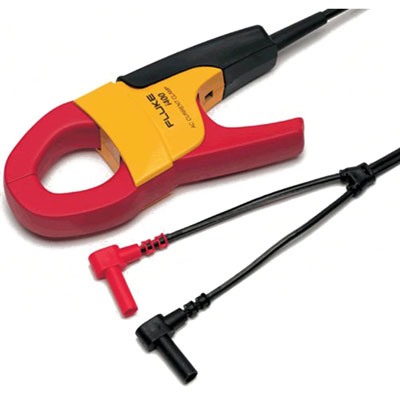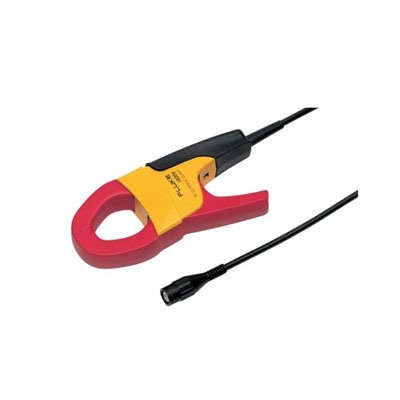To make the most out of your digital multimeter, you need a quality AC current clamp to provide accurate readings on your meter. Fluke designed and produced the i400 and i400s models to pair with many of their multimeter products. We’ll evaluate these clamps based on output, range, and safety before providing a recommendation.
Fluke i400
If you need a way to obtain accurate current measurements and cannot break the electric circuit, the Fluke i400 delivers a powerful punch. It allows for safe measurements with the highest industry safety ratings. This clamp has a safety rating of CAT IV 600 V/CAT III 1000 V, making it a leader in the field.
The Fluke i400 can measure up to 400 A AC with a continuous current range of 1 A – 400 A. Its maximum non-destructible current is 1000 A. This clamp delivers its output as 1 mA/A, guaranteeing your meter can easily provide readings.
It also features a non-slip overmold handle. In addition to being soft, this handle will prevent you from accidentally touching the wire.
While the Fluke i400 is compact, it still has the downside of being relatively bulky. This impacts its ability to handle thinly packed heavy gauge wire effectively. Additionally, it does not measure DC current, so you will need another device for that purpose.
The Fluke i400 works with a range of Fluke products, including digital multimeters, insulation testers, portable oscilloscopes, and mA loop calibrators. It must be used with devices that have a mA range.
Fluke i400s
The Fluke i400s is another option for measuring currently accurately without breaking electric circuits. Like the Fluke i400, its safety rating is CAT IV 600 V/CAT III 1000 V. It’s ideal for use with a Fluke digital multimeter or portable oscilloscope.
With many similarities between the Fluke i400 and i400s, including the ability to measure up to 400 A AC and a maximum non-destructive current of 1000 A AC. However, the Fluke i400s has some advantages over the i400. First, it is dual range. You can measure 40 A or 400 A with this clamp. Second, the output is in mV/A instead of mA/A. For the 40 A range, the output is 10mV/A, and for the 400 A range, the output is 1mV/A.
When combined with an oscilloscope, the Fluke i400s provides a range of readings, including min/max current spikes, noise, and differential. This makes it highly advantageous to have for any detailed electrical work.
Similar to the Fluke i400, it features a non-slip, soft overmold. While working, you’ll experience the ultimate comfort with no risk of accidental slips.
Our Recommendation
While both the Fluke i400 and i400s offer exceptional benefits to those needing advanced readings with their digital multimeters and oscilloscopes, the Fluke i400s offers some perks that make it the more advanced and potentially better choice. With the ability to read in dual ranges, you’ll have better accessibility to the information you need.
However, the choice will ultimately depend on your multimeter or oscilloscope. If you have equipment that requires mA/A input, you’ll need the Fluke i400. On the other hand, if you have equipment requiring mV/A input, you should select the Fluke i400s. Ultimately, the device you will pair the clamp with will determine which clamp you select.
Click here to purchase Fluke i400 on Amazon.com
Click here to purchase Fluke i400s on Amazon.com

